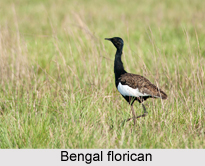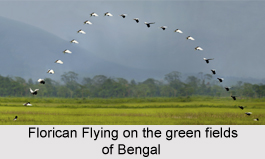 Bengal Florican is an Indian bird under the bustard family. Bengal florican has the scientific name "Houbaropsis bengalensis". This bird is also called Bengal bustard.
Bengal Florican is an Indian bird under the bustard family. Bengal florican has the scientific name "Houbaropsis bengalensis". This bird is also called Bengal bustard.
Structure of Bengal Florican
The adult Bengal Floricans range from 66 to 68 centimetres in length and stand around 55 cm tall. The male Bengal florican has black plumage from the head and neck to underparts. The head of Bengal Florican carries a long lanky crest, and the neck has elongated display plumes. The upper side is buff with fine black vermiculations and black arrowhead markings. While in flight, the male`s wings appear entirely white except for the dark primary remiges. The feet and legs are yellow, the bill and irides are dark.
Sexes of Bengal Florican
The female Bengal Floricans are larger than the males and have a buff-brown colour similar to the males` back, with a dark brown crown and narrow dark streaks down the side of the neck. Their wing coverts are lighter than the remiges and covered in fine dark barring. Immature birds look like females. The adult female Bengal florican weigh around 1.7-1.9 kg against a weight of 1.2-1.5 kg (2.6-3.3 lb) in males.
Population of Bengal Florican
Bengal Florican has two disjunctive populations, one in the Indian subcontinent, and another in Southeast Asian countries. Bengal Florican migrates through Uttar Pradesh through the Terai Region of Nepal to Assam and Arunachal Pradesh in India, and Bangladesh.
Concentration of Bengal Florican
Bengal Floricans live in open tall grassland habitats with scattered bushes. The most important grass species are satintails, sugarcane, as well as Desmostachya bipinnata. Bengal Florican is usually encountered in the early mornings and evenings and is most easily spotted in the breeding season from March to August, which is when most censuses of the population are conducted.  They stay between March and May, when they give their stunning courtship display; the male Bengal bustards are far more conspicuous than the cryptically-coloured females, which moreover prefer high grassland rich in sugarcane.
They stay between March and May, when they give their stunning courtship display; the male Bengal bustards are far more conspicuous than the cryptically-coloured females, which moreover prefer high grassland rich in sugarcane.
Threats to Bengal Florican
Bengal Florican is one of the rarest bustard. Bengal Florican or Bengal bustard is restricted to tiny fragments of grassland scattered across South and Southeast Asia. It is known to have become increasingly threatened by land conversion for intensive agriculture, particularly for dry season rice production. The poaching of Bengal Florican continues to be a problem in Southeast Asia, while the South Asian population is down to less than 350 adult birds, about 85 percent of which are found in India. The population of Bengal florican has decreased dramatically in past decades.



















